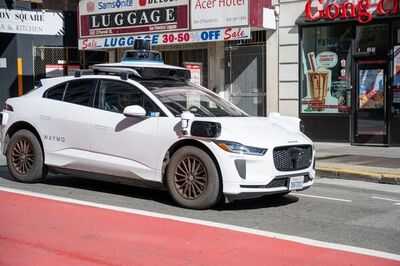
Mike Johns was trapped, and growing desperate. The tech entrepreneur's flight home to Los Angeles was departing shortly, but his taxi was making repeated circles in the airport parking lot in Scottsdale, Arizona, and he could not escape.
On any other day he might have begged the cab driver to pull over and end his dizzying misery.
But like an episode of dystopian sci-fi series Black Mirror come to life, Johns was caught in a self-driving vehicle with nobody in the car but himself and a computer programme that had gone rogue.
"I got my seatbelt on, I can't get out of the car!" he lamented to a customer service agent he finally reached on his mobile phone. "Has this been hacked? What's going on? I feel like I'm in the movies. Is somebody playing a joke on me?"
Johns' wild ride in January is among a succession of problems that have plagued Waymo, the robocar taxi service that this week won approval to bring its fleet of self-driving cabs to London next year.
"Great news, Londoners!" declared the company in a welcoming statement. "We're bringing our fully autonomous ride-hailing service across the pond, where we intend to offer rides - with no human being behind the wheel - in 2026."
But is Britain ready for the attack of the robocars, which, if their experience in America is any guide, could spread across the country like the Day of the Triffids?
Waymo's driverless taxis have experienced a succession of troubles for its passengers, other motorists trying to share the road, frustrated pedestrians and bewildered police.
On Britain's overcrowded highways, where drivers compete for space with buses, bikes and scooters, the addition of robocars is hoped to make our streets less dangerous.
"Autonomous vehicles, such as Waymo, hold the potential to significantly improve road safety because, quite simply, the human driver is removed," says James Gibson, executive director of Road Safety GB. "The data shows that the Waymo vehicles have performed far safer compared to human drivers across more than 100 million autonomous miles."
But the experience of many Americans suggests that not everyone will welcome them.
When driving I always give the gleaming white all-electric Jaguar I-PACE cars a wide berth, just to be safe. The sight of a driverless vehicle cruising city streets is unnerving, like seeing a ghost taking a joy ride.
And Mike Johns' ordeal trapped in a circling Waymo was far from unique.
Waymo passengers complained they were terrified when their robocab unexpectedly parked in the middle of fast-moving Expressway traffic on "one of the scariest streets in Austin," Texas, in April. They were locked inside the vehicle as cars barrelled by.
"We kept saying, 'We're on a highway, please move the car!'" recalls passenger Becky Navarro. "Cars kept honking at us, and it would not move. It would not let us out."
Navarro claims that a customer service agent only unlocked the car when she threatened to post live video on TikTok.
Recent college graduates Aiselyn Hall and Emmie Wuest were driving in Tempe, Arizona, when their car was confronted by an oncoming Waymo driving the wrong way down the street in August 2024.
"I was like, oh my god, we might actually get hit here," says Wuest.
Hall spotted the robocar's passenger helplessly trapped inside. "He couldn't do anything, and that was what was so scary," she says. "He threw his hands up."
The two friends had previously hailed the driverless taxis, and Hall adds: "We thought we were a little bit safer in Waymo. Now we're not taking Waymo again."
The US Traffic Safety Administration reported 462 traffic accidents involving Waymo vehicles last year, including one fatality. Waymo was sued in June after cyclists complained that its "safe exit" system failed to prevent bike riders being hit by car doors as passengers depart.
Waymos have frustrated other motorists by stopping in intersections, getting stuck in road closures, and causing gridlock on busy city streets. Road works, unusual weather conditions or difficult lighting can confuse Waymo cars, which halt, adding to congestion.
Two Waymo cars caused a massive backup when they inexplicably stopped in the middle of a major road blocking both lanes just as a San Francisco Giants baseball game ended, leaving thousands of fans stuck going nowhere last year.
Waymo, a subsidiary of Google's parent company Alphabet Inc., recalled more than 1,200 self-driving cars in May to fix a software flaw that made it difficult for them to see low-visibility objects such as chains and gates across a road, which had caused a number of collisions.
Police have even complained that when they pull over a Waymo for driving offences such as making an illegal U-turn, they have no idea who to give the citation to since the driver's seat is empty.
Pedestrians have also complained about Waymo cars blocking their path, or making too much noise.
Residents near a car park used by dozens of Waymo vehicles in San Francisco have been angered by the autonomous cars getting confused and honking at each other throughout the night, for weeks on end.
"Over the past two weeks I've been woken up more times overnight than I have combined over 20 years," said Russell Popovski.

Ruth Healey, president of leading women's organisation Soroptimist International Great Britain and Ireland
"As Soroptimists, we're optimistic about the introduction of driverless taxis in the UK. They have the potential to make a significant positive impact on women's safety, particularly when travelling alone or at night.
"For many women, using traditional taxis can carry a degree of risk - from uncomfortable interactions to instances of harassment or assault by drivers. Where we might like to see more women in the taxi profession, autonomous vehicles remove this human element altogether, offering a neutral, predictable, and closely monitored travel experience.
"With built-in GPS tracking, onboard cameras, and direct links to control centres and trained assistance, driverless taxis can provide constant oversight and immediate response options if a passenger feels unsafe. Automated systems ensure that routes are followed exactly as planned, without detours or intimidation.
"Most importantly, driverless fleets can be designed with safety at the forefront. We'd urge organisers to carry out a Gender Impact Assessment (GIA) during development to ensure decision-making is fair for everyone. A GIA can identify gaps affecting women, who are more likely to experience unwanted attention. Features such as well-lit interiors, voice-activated emergency functions, and secure entry systems will be key.
"Driverless taxis could also make late-night travel safer and more accessible for women working shifts or returning home after dark, reducing reliance on walking or waiting alone.
"Ultimately, while driverless technology is still developing, its potential to eliminate the safety concerns associated with human-driven taxis could mark a major step forward for women's personal security and confidence in public travel."
Frustrated pedestrians have also hit back at Waymos. Pranksters deliberately ordered 50 Waymo cars to converge on San Francisco's longest dead end street in July, causing a massive jam. Others have intentionally blocked the cars' path, causing the vehicles to stall.
Among those expected not to roll out the red carpet for Waymo are the drivers of London's famous black taxis, who can spend years learning 'the Knowledge' to qualify as cab drivers. It will also put greater pressure on gig economy workers who drive for apps like Lyft and Uber.
Yet however flawed robocars may be on occasion, statistics show they have far better safety records than human drivers.
"They are always on point," says Andrew Maynard, professor of advanced technology transitions at Arizona State University, who is also a regular Waymo user. "They are not like humans that are looking at their phones, listening to music, eating, looking down at the floor. They are quite aware of their surroundings.
"Waymo at the moment is making I think 100,000 trips a week. That's a phenomenal number of people taking Waymo without a human driver. Yes, you're going to have the odd occasion when they do weird things, but it's a fraction of the trips that are being driven."
Waymo cars have already driven more than 100 million autonomous miles in the US, on more than 10 million rides, and the vehicles are now being tested in Japan.
UK Transport Secretary Heidi Alexander said this week: "I'm delighted that Waymo intends to bring their services to London next year . . . Boosting the AV [Autonomous Vehicle] sector will increase accessible transport options alongside bringing jobs, investment and opportunities to the UK."
And despite their concerns, Los Angeles police found one benefit to robocars when a Waymo taxi was used as a getaway vehicle after a grocery store robbery. Police had a Waymo agent remotely disable the car until officers arrived.
Waymo also frequently updates its software, hoping to eliminate many of its problems.
As for Mike Johns in his endlessly circling robotaxi, a Waymo customer service agent was finally able to wrest control of the vehicle remotely, and the businessman caught his flight with minutes to spare.
Magnanimously, Waymo waived its fee for the trip.
As the robocars head to Britain, customers might think twice, just in case they get Way Mo' than they bargained for.
MAYBE
Daniel Hammond, 33, Photographer
"You can never really be sure about safety and that includes when a person is driving the car. With more testing, it will be more safe in the future than it is now. I would, maybe, trust it in five or ten years."
NO
Soinja Hammond, 32 Project Manager
"Something could happen while you're in the car when there isn't a person there to stop it. My own feeling is that I wouldn't feel safe."
YES
Dan Smith, 32, Management Consultant
"I am from the United States but have never given these a try. In their current state I think that driverless cars are working. They are only growing. There is definitely going to be a huge push going forward."
NO
Julia Alpar, 40, Head of Engagement
"I would not feel safe getting into one, I think we are many years away from having the technology for reliable driverless cars."
NO
Saqib Ahmed, 29, Engagement Officer
"I wouldn't get into a car without a human driver. There is more room for error with a driverless vehicle. I would take more comfort in the fact that a person can make a decision there and then on what to do if something were to go wrong."
You may also like

J&K Crime Branch submits charge sheet against 8 accused in land fraud case

Women's World Cup: Very Difficult To Play With One Less Batter Against England, Says Anjum Chopra

Chhattisgarh: Bastar to witness historic surrender of over 200 Maoists today

Shivraj Chouhan directs officials for timely implementation of PM Dhan-Dhaanya Krishi Yojana

Narak Chaturdashi 2025: Date, Significance, and How to Properly Light the Yam Deep






